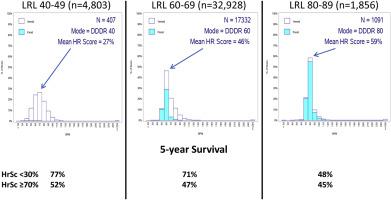Heart Rhythm ( IF 5.6 ) Pub Date : 2021-08-08 , DOI: 10.1016/j.hrthm.2021.07.068 Arjun D Sharma 1 , Bruce L Wilkoff 2 , Mark Richards 3 , Nicholas Wold 4 , Paul Jones 4 , David Perschbacher 4 , Brian Olshansky 5

|
Background
No real-world large database associates lower rate limit (LRL) programming and survival of subjects with cardiac resynchronization therapy–defibrillators (CRT-Ds).
Objective
The purpose of this study was to test the hypothesis that lower LRL programming is independently associated with survival, and that LRL and heart rate score (HrSc) are associated.
Methods
All dual-chamber CRT-D devices in the Remote Patient Monitoring (RPM) ALTITUDE database (2006–2011) were queried. Baseline HrSc was defined as the percentage of all atrial sensed and paced beats in the tallest 10-beat histogram bin postimplant. LRL was assessed during repeated RPM uploads. Using a Cox model multivariable analysis, relationships between LRL, survival, HrSc, and other variables were evaluated. Survival was determined by query of death indices.
Results
Data analyzed included 61,881 subjects (mean follow-up 2.9 years). LRL ranged from 40 to 85 bpm. Baseline lower LRL was associated with younger age, less atrial fibrillation, female sex, and lower HrSc (P <.001 for all covariates). Lower LRL was associated with improved survival, with LRL 40 associated with the largest survival benefit. This was significant for all 3 HrSc subgroups (P <.001). An interaction between HrSc and LRL was observed, with the largest survival difference between HrSc groups observed at LRL-40 (P <.001).
Conclusion
LRL programming and HrSc were associated, and lower values of both were associated with improved survival in a large database of CRT-D subjects. Relationships between survival, LRL programming, and HrSc merit further study.
中文翻译:

心脏再同步除颤器起搏的速率下限:是否应重新考虑低速率编程?
背景
没有真实世界的大型数据库将下限 (LRL) 编程和受试者的生存与心脏再同步治疗除颤器 (CRT-Ds) 相关联。
客观的
本研究的目的是检验较低的 LRL 编程与生存独立相关的假设,以及 LRL 和心率评分 (HrSc) 相关的假设。
方法
远程患者监护 (RPM) ALTITUDE 数据库 (2006-2011) 中的所有双腔 CRT-D 设备均被查询。基线 HrSc 定义为植入后最高 10 拍直方图箱中所有心房感应和起搏搏动的百分比。在重复 RPM 上传期间评估 LRL。使用 Cox 模型多变量分析,评估 LRL、生存、HrSc 和其他变量之间的关系。通过查询死亡指数确定存活率。
结果
分析的数据包括 61,881 名受试者(平均随访 2.9 年)。LRL 范围为 40 至 85 bpm。基线较低的 LRL 与年龄较小、房颤较少、女性和较低的 HrSc 相关(所有协变量的P <.001)。较低的 LRL 与提高生存率相关,LRL 40 与最大的生存获益相关。这对所有 3 个 HrSc 亚组都很重要(P <.001)。观察到 HrSc 和 LRL 之间的相互作用,在 LRL-40 观察到 HrSc 组之间的生存差异最大 ( P <.001)。
结论
LRL 编程和 HrSc 相关,在大型 CRT-D 受试者数据库中,两者的较低值与提高生存率相关。生存、LRL 编程和 HrSc 之间的关系值得进一步研究。











































 京公网安备 11010802027423号
京公网安备 11010802027423号